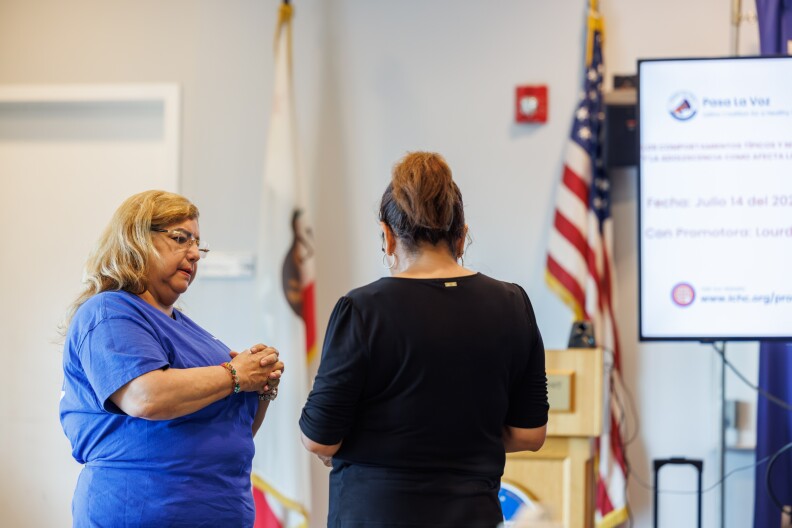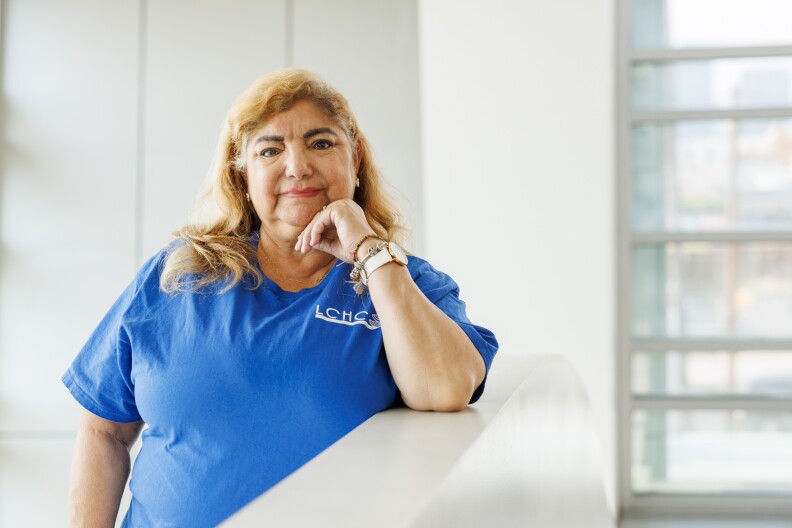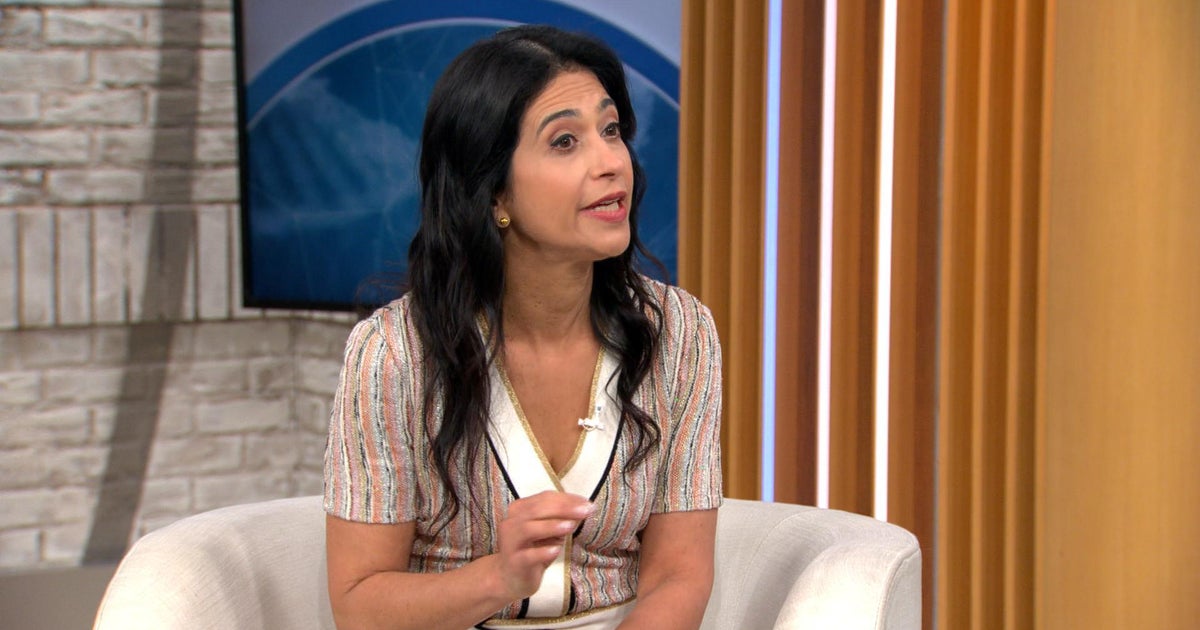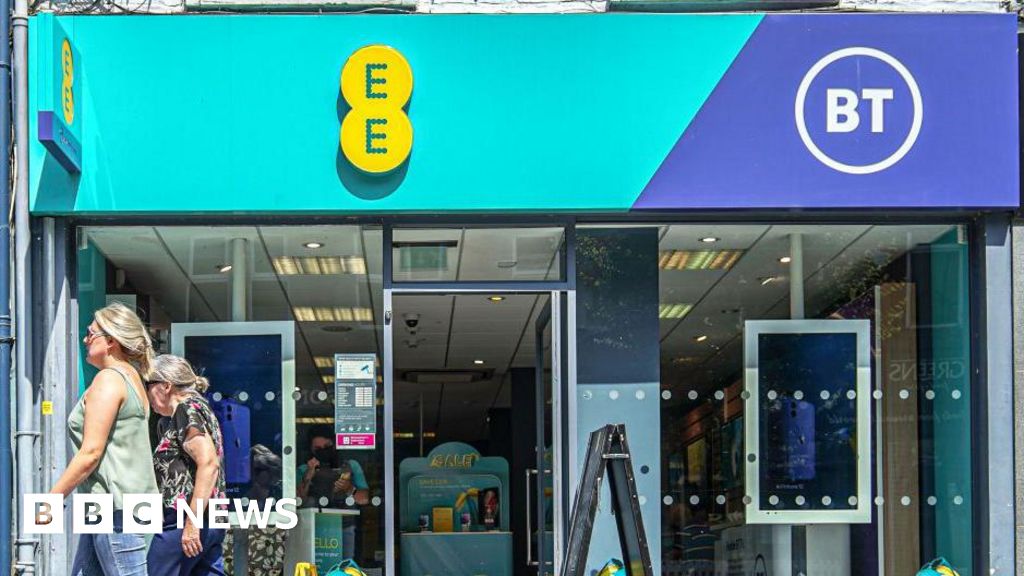Fortina Hernández is called “the one who knows it all.”
For more than two decades, the community health worker has supported hundreds of families throughout southeast Los Angeles by helping them sign up for food assistance, sharing information about affordable health coverage, and managing medications for their chronic illnesses. She’s guided by the expression “an ounce of prevention is worth a pound of cure.”
But she makes only around $20 an hour from a community health organization and must hold down a second job to make ends meet. “They pay us very little and expect too much,” she said in Spanish. "We build trust. We offer support. We’re the shoulder people rely on, but we don't get fair wages."
California looked to professionalize thousands of community health workers such as Hernández to improve the health of immigrant populations, particularly Hispanic residents, who often experience higher rates of chronic diseases, are more likely to be uninsured, and face more cultural and linguistic barriers when trying to access services. Studies show their work may reduce hospitalizations as well as emergency room and urgent care visits.
The state hewed closely to a series of expert recommendations put out in 2019 to standardize training and certification, integrate these workers into the health care workforce, and provide fair wages, including reimbursements through Medi-Cal, the state’s Medicaid health insurance program, to compensate for work that traditionally has been done on a volunteer basis or for low pay. But six years in, California has backed out of many of those initiatives.
The state has eliminated a certification program and rolled back nearly all funding to train and expand this workforce even though it set a goal of 25,000 workers by this year. Although Medi-Cal began covering their services, participating health plans set uneven billing requirements, making it difficult for workers to get reimbursed. And the state didn’t follow through on a planned pay raise.
With federal funding cuts just passed and President Donald Trump targeting immigrants for deportation — even sharing personal Medicaid data with the Department of Homeland Security — advocates fear California is abandoning its health equity initiative for immigrants, people of color, and people with low incomes when they say that effort is needed most.
“We're in a very dire situation right now,” said Cary Sanders, senior policy director for the California Pan-Ethnic Health Network, a statewide health equity advocacy group.
A spokesperson for Gov. Gavin Newsom, Elana Ross, said “the state has taken difficult but necessary steps to ensure fiscal stability” and that the administration continues to have a dialogue with community health workers. Ross added that the Democratic governor, a potential presidential candidate, remains committed to defending immigrants being targeted by the Trump administration.
‘Our office is on the street’

Lourdes Bernis (left) chats with a resident about Latino health issues. Bernis is a community health worker, or promotora, who helps people manage chronic illnesses, connects them to social services, and promotes healthy lifestyles.
(
Elisa Ferrari
/
for KFF Health News
)
There are more than 60,000 community health workers nationwide, including roughly 9,200 in California, and this workforce is projected to grow 13% over the next decade, three times as fast as for all occupations, according to 2024 data from the U.S Bureau of Labor Statistics. But experts say these numbers are an undercount given the various titles community health workers hold and that many work outside of health care and governmental institutions.
Community health worker is an umbrella term that includes peer supporters and community health representatives. These workers, often known as promotores, tend to be women who work in clinics, hospitals, public health departments, and local nonprofits, places where they are trusted and have a grasp of their community’s most pressing health needs.
Besides helping people manage chronic illnesses such as heart disease and diabetes, they promote reproductive health, children’s health, and oral hygiene, and they help seniors with dementia prevent injuries and review medications. They can make people feel safe when reporting domestic violence and other abuses. They also connect people to housing and food assistance. "The community health worker is not sitting at a desk," Hernández said. "Our office is on the street."
Back in 2019, the California Future Health Workforce Commission recommended integrating community health workers into the health care system, and in 2022, the state authorized $281 million over three years for the California Department of Health Care Access and Information, which oversees health care workforce development, to recruit, train, and certify them.
The agency sought to standardize training and certification, but some community groups feared that would create barriers to entry by not giving enough credit for lived experiences and cultural competency. But just as the agency offered more flexibility and allowed community-based training, the state slashed $250 million in funding last year due to budget constraints. This year, the certification program was officially eliminated.
Spokesperson Andrew DiLuccia said the agency is now considering a program to accredit community organizations rather than individual workers and plans to spend its remaining $12 million on technical assistance, workforce development, and salaries for those working with immigrant communities.
According to the National Academy for State Health Policy, 32 other states offer a voluntary or mandatory community health worker certification program.
Some community health advocates say California’s missing an opportunity to carve a career path for this workforce. Currently, some courses offered by nonprofits, counties, and colleges require a fee, a degree, English fluency, or prior experience. Most are concentrated in the San Francisco or Los Angeles area, leaving training deserts in much of the state.

Lourdes Bernis received training that allowed her to move into a full-time role with the Los Angeles County Department of Mental Health. She says many community health workers remain stuck in low-paying positions and can’t afford training to advance.
(
Elisa Ferrari for KFF Health News
)
Lourdes Bernis, a dentist from Ecuador, is a model for how community health workers could be integrated into the health care system. She began as a volunteer promotora more than a decade ago and in 2019 received free training from Los Angeles County, allowing her to move into a full-time job with benefits for the county’s Department of Mental Health to help Spanish-speaking women manage depression and anxiety as they recover from drug use.
Bernis now plans to become a peer-to-peer support specialist inside hospitals and clinics. Meanwhile, many of her colleagues with decades of experience remain stuck in low-paying roles and can’t afford training to advance. “There are promotoras who have 20 to 25 years of experience, but they are still volunteering,” Bernis said in Spanish.
Medi-Cal's role
To pay community health workers, Medi-Cal began covering their services in July 2022, but California suspended a planned pay increase for them after voters approved Proposition 35, which hiked the pay of physicians, hospitals, community clinics, and other providers instead. Since then, the state has yet to establish a uniform system for how health plans should contract with organizations that employ community health workers.
“We have to jump through hoops,” said Maria Lemus, executive director at Visión y Compromiso, a Los Angeles-based nonprofit representing community health workers. “It just causes havoc, because each plan could have different requirements.”
Lemus said it took the organization nearly six months to establish payment with one health plan.
And though Medi-Cal reimbursements are tied to individual tasks, ranging from $9.46 to $27.54 for 30 minutes of work, advocates say they aren’t fully compensated for the time they spend building trust and following up with patients. Advocates say these workers should earn at least $30 a visit, with benefits, but many earn about $21 an hour, often without benefits.
Advocates say they’re surprised by how infrequently these services are used in a program with 15 million Californians. More than 16,000 Medi-Cal enrollees used these services in the first year, rising to 68,000 last year, according to state data. “I don't think it's reached the potential that the governor talked about, and that we all imagined that it could possibly achieve,” Sanders said.
Griselda Melgoza, a spokesperson for the California Department of Health Care Services, said the agency, which administers Medi-Cal, has seen “a steady, upward trend” and believes the data underestimates utilization because the benefit is sometimes bundled with other services.
A proposal to assess whether Medi-Cal managed care plans are doing enough outreach and education to enrollees about community health services died this year.
More crucial than ever
With health funding cuts from the Trump administration and passage of the GOP’s tax and spending legislation, advocates fear there will be even less funding and support for community health worker positions, shrinking a workforce tackling health disparities. Already, Fresno County’s Department of Public Health said it has cut its community health workers by more than half, from 49 positions to 20.
Yet, outreach is more crucial than ever. As the Trump administration continues immigration raids, which appear to have targeted at least one health clinic in the state, advocates and policy researchers say community health workers could act as intermediaries for immigrant patients afraid to seek medical care in hospitals and clinics.
Without a state certification program, no raises, and dwindling training funds, the path to professionalizing community health workers is unclear, leaving workers feeling left behind.
"The community trusts me,” said Hernández, the veteran community health worker, “but at the government level, there’s still a long way to go before this work is valued and fairly compensated."
This article was produced by KFF Health News, a national newsroom that produces in-depth journalism about health issues and is one of the core operating programs at KFF — the independent source for health policy research, polling, and journalism. KFF Health News is the publisher of California Healthline, an editorially independent service of the California Health Care Foundation.
-
KFF Health News, formerly known as Kaiser Health News (KHN), is a national newsroom that produces in-depth journalism about health issues and is one of the core operating programs at KFF — an independent source of health policy research, polling and journalism.
-
Copyright 2025 KFF Health News. To see more, visit KFF Health News.








 English (US) ·
English (US) ·